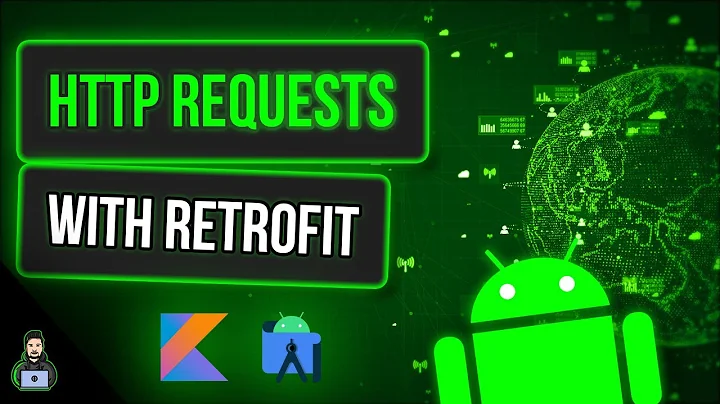Multiple converters with Retrofit 2
You need to return null from the Converter.Factory if the type does not match. Keep the Class<?> around in a field to compare it against.
@Override
public Converter<ResponseBody, ?> fromResponseBody(Type type, Annotation[] annotations) {
if (!this.type.equals(type)) {
return null;
}
return new HALResponseBodyConverter<>(gson);
}
This will allow multiple instances to be used because each only applies to its own type.
That said, however, you can probably get away with only using a single converter and pulling the class from the Type that is passed in.
@Override
public Converter<ResponseBody, ?> fromResponseBody(Type type, Annotation[] annotations) {
if (!HALResponse.class.isAssignableFrom(type)) {
return null;
}
// TODO create converter with `type` now that you know what it is...
}
You can look at the Wire converter in the repo which does this for a full example.
Related videos on Youtube
Gabor
Updated on June 15, 2022Comments
-
Gabor about 2 years
I have a HATEOAS (HAL) REST service and managed to talk to it with the code below (using halarious as a conversion engine) but when I try to merge the converters (
stalloneandstallone2), the app will always pick up the first converter, instead of the one that is appropriate for the response type which of course leads to an error.How could I avoid duplicate retrofits that are only different in a small type detail?
public interface Stallone { @GET("/discovery") Call<DiscoveryResponse> discover(); @POST() Call<LoginResponse> login(@Url String url, @Body LoginRequest secret); }public static void main(String... args) throws IOException { // Initialize a converter for each supported (return) type final Stallone stallone = new Retrofit.Builder() .baseUrl(BASE) .addConverterFactory(HALConverterFactory.create(DiscoveryResponse.class)) .build().create(Stallone.class); final Stallone stallone2 = new Retrofit.Builder() .baseUrl(BASE) .addConverterFactory(HALConverterFactory.create(LoginResponse.class)) .build().create(Stallone.class); // Follow the HAL links Response<DiscoveryResponse> response = stallone.discover().execute(); System.out.println(response.code() + " " + response.message()); Assert.assertNotNull(response.body()); String loginPath = response.body().getLogin(); Assert.assertEquals(loginPath, "/login"); // Follow another link if (loginPath.startsWith("/")) loginPath = loginPath.substring(1); Response<LoginResponse> response2 = stallone2.login(loginPath, new LoginRequest(AUTH0TOKEN, null)).execute(); System.out.println(response2.code() + " " + response2.message()); Assert.assertNotNull(response2.body()); String setupPath = response2.body().getSetup(); Assert.assertEquals(setupPath, "/setup"); System.out.println("All OK!"); }public final class HALConverterFactory extends Converter.Factory { private final Gson gson; public static HALConverterFactory create(Class<?> type) { return new HALConverterFactory(type); } private HALConverterFactory(Class<?> type) { if (!HalResource.class.isAssignableFrom(type)) throw new NullPointerException("Type should be a subclass of HalResource"); GsonBuilder builder = new GsonBuilder(); builder.registerTypeAdapter(HalResource.class, new HalSerializer()); builder.registerTypeAdapter(HalResource.class, new HalDeserializer(type)); builder.setExclusionStrategies(new HalExclusionStrategy()); this.gson = builder.create(); } @Override public Converter<ResponseBody, ?> fromResponseBody(Type type, Annotation[] annotations) { return new HALResponseBodyConverter<>(gson); } @Override public Converter<?, RequestBody> toRequestBody(Type type, Annotation[] annotations) { return new GsonRequestBodyConverter<>(gson, type); } }final class HALResponseBodyConverter<T extends HalResource> implements Converter<ResponseBody, T> { private final Gson gson; HALResponseBodyConverter(Gson gson) { this.gson = gson; } @Override public T convert(ResponseBody value) throws IOException { BufferedSource source = value.source(); try { String s = source.readString(Charset.forName("UTF-8")); return (T) gson.fromJson(s, HalResource.class); } catch (Exception e) { throw new RuntimeException(e); } finally { closeQuietly(source); } } private static void closeQuietly(Closeable closeable) { if (closeable == null) return; try { closeable.close(); } catch (IOException ignored) { } } }Again, the problem is that when you try to shorten the above like this:
final Stallone stallone = new Retrofit.Builder() .baseUrl(BASE) .addConverterFactory(HALConverterFactory.create(DiscoveryResponse.class)) .addConverterFactory(HALConverterFactory.create(LoginResponse.class)) .build().create(Stallone.class);you'll get an exception at the
Response<LoginResponse> response2 = ...line:Exception in thread "main" java.lang.ClassCastException: com.example.retrofit.DiscoveryResponse cannot be cast to com.example.retrofit.LoginResponse
-
 naXa stands with Ukraine over 7 yearsWhat's
naXa stands with Ukraine over 7 yearsWhat'sGsonRequestBodyConverter?
-
-
 Shishir Shetty almost 5 yearsWhere can I find EditUserXmlConverterFactory?
Shishir Shetty almost 5 yearsWhere can I find EditUserXmlConverterFactory? -
 Shishir Shetty almost 5 yearsAlso, where to write this: if (type != NeedToBeXML.class) return null; ?
Shishir Shetty almost 5 yearsAlso, where to write this: if (type != NeedToBeXML.class) return null; ?











